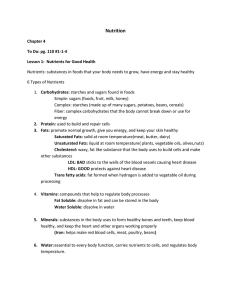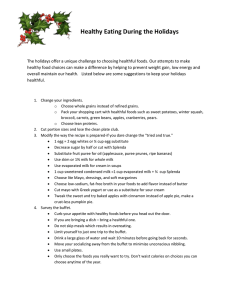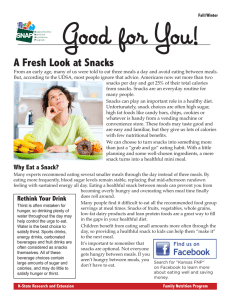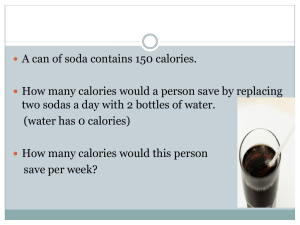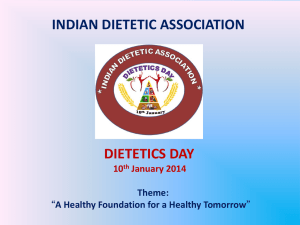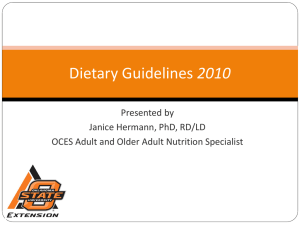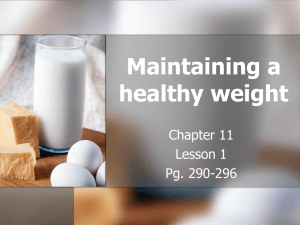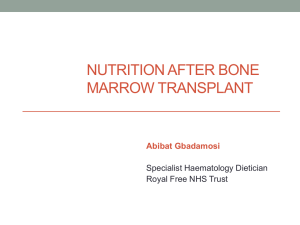Guidelines for Healthful Eating
advertisement
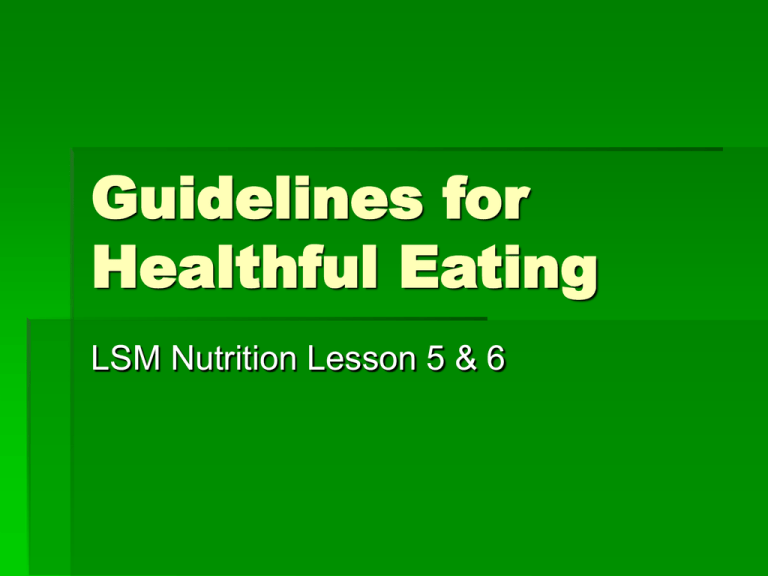
Guidelines for Healthful Eating LSM Nutrition Lesson 5 & 6 Instant Activity Make a word web of healthful eating habits. Write “Healthful Eating” in the middle of a sheet of paper. Then, around the edges of the paper, add phrases such as “Eat five fruits and vegetab;es a day” – one phrase for each of the major food groups. Connect these to the center phrase. Dietary Guidelines Are a set of recommendations for healthful eating and active living . The recommendations are grouped in three broad areas. ABC’s of good health – will help you stay balanced and away from disease A: Aim for Fitness Aim for a healthy weight: A healthcare professional can help you determine a healthy weight for your age height and body. Be physically active each day: Daily activity benefits your overall health and can improve fitness. At least 60 minutes of moderate activity will help to maintain fitness. B: Build a Healthy Base The base of this food plan is the Food Guide Pyramid Make food Choices carefully – eat the recommended number of daily servings Choose a variety of grains- especially whole grains Keep food Safe to eat – When in doubt, toss it out! Maintaining a Healthy Weight Here’s one way to get a rough idea of our daily calorie needs. If you are extremely inactive- you need about 12 calories per pound to stay at your current weight. If you are involved in light activity, such as doing homework or household tasks, you need about 15 calories per pound to maintain weight. If you are moderately active, such as brisk walking, cycling – you need about 20 calories per pound Example: If you are a moderately active person weighing 140 lbs, your needs are 140 x 20 or 2,800 calories a day Food Guide Pyramid Useful tool to making good selections Represents a clear, useful depiction of current recommendations for healthful eating. Following these recommendations offers important health benefits to people of all ages. Including: Increased energy and improved physical and mental performance Achievement of a healthful body weight Protection against five of the ten leading causes of death, including stroke, cancers, diabetes and atherosclerosis. On the Go Food Choices Skipping a meal may seem easy, but its hard on your growing body. To get the balanced nutrition you need, plan ahead. Make a list of at least five healthy food choices you can eat “on the run” or carry in your backpack. Think about food rich in nutrients and low in saturated fats and cholesterol. Moderate Fats While some dietary fat is good for health, most Americans eat too many fats. The guidelines present no more than 30% of daily calories come from fats. Most Americans consume a diet that averages a significantly higher percentage. Eating less fat, especially unsaturated lowers your chance of cardiovascular disease. Moderation in Sugar You might think you don’t eat much added sugar, but sugars are hidden everywhere! You an moderate sugar intake by : Learning to identify added sugars by their names ( corn syrup, HFCS, honey, molasses – anything with an – ose ending!) Balancing foods Limiting the intake or replacing regular fruit juice with 100% fruit juice – or cutting the contents in half with water Choosing fresh fruits of canned fruit in water instead of syrups. Moderation in Salt Sodium is an essential mineral Helps transport nutrients intro your cells and helps move wastes out. Helps maintain normal blood pressure and nerve function. Most Americans ingest too much from processed foods Moderation in Salt Consuming less salt prevents high blood pressure and may also benefit your skeletal system by decreasing the loss of calcium from bones Try this to moderate: Read food labels Season foods with herbs and spices At restaurants – ask for foods without salt Taste foods before you salt them Choose fruits and veggies often Evaluating For lunch, Josh had a cheeseburger, fries and a non diet soda. What could he choose for his afternoon snack and dinner to balance out his high fat, high sugar high salt meal? Social Studies Choose a country and research their eating patterns You can interview a foreign student Learn and find answers to questions such as: How many meals are eaten each day? What are some typical meals? Are foods high or low in fat, sugar, and salt? Are snacks an important part of the eating plan? What percentage of meals are eaten at home? Are fast foods popular? Imagine you are from that country Write a letter describing your typical diet, favorite foods…etc. Check work for spelling and grammar Real Life Applications Smart Snacking In small groups, create a poster that encourages teens to adopt healthful eating habits. Use labels, pictures from magazines, computer graphics or your own illustrations. In a paragraph, explain your picture and why it represents personal wellness. Assessment Your work should provide evidence of the following: Identification of healthful snacks low in fat and sugar Explanation of how the information on labels can help you choose nutritious snacks and meals
